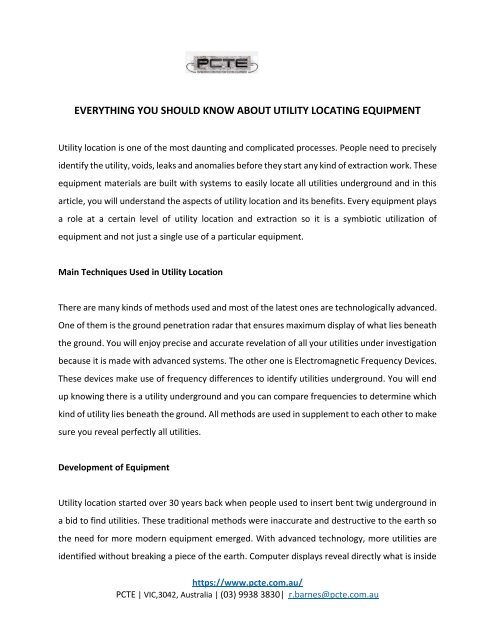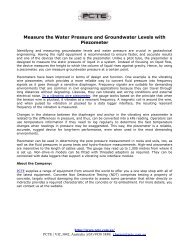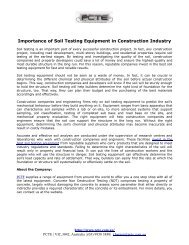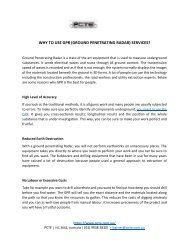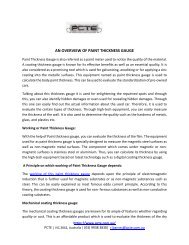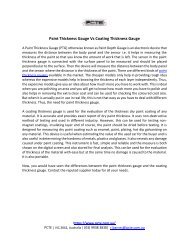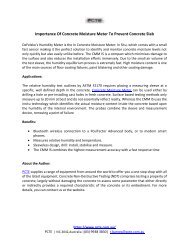EVERYTHING YOU SHOULD KNOW ABOUT UTILITY LOCATING EQUIPMENT
Utility location is one of the most daunting and complicated processes
Utility location is one of the most daunting and complicated processes
Create successful ePaper yourself
Turn your PDF publications into a flip-book with our unique Google optimized e-Paper software.
<strong>EVERYTHING</strong> <strong>YOU</strong> <strong>SHOULD</strong> <strong>KNOW</strong> <strong>ABOUT</strong> <strong>UTILITY</strong> <strong>LOCATING</strong> <strong>EQUIPMENT</strong><br />
Utility location is one of the most daunting and complicated processes. People need to precisely<br />
identify the utility, voids, leaks and anomalies before they start any kind of extraction work. These<br />
equipment materials are built with systems to easily locate all utilities underground and in this<br />
article, you will understand the aspects of utility location and its benefits. Every equipment plays<br />
a role at a certain level of utility location and extraction so it is a symbiotic utilization of<br />
equipment and not just a single use of a particular equipment.<br />
Main Techniques Used in Utility Location<br />
There are many kinds of methods used and most of the latest ones are technologically advanced.<br />
One of them is the ground penetration radar that ensures maximum display of what lies beneath<br />
the ground. You will enjoy precise and accurate revelation of all your utilities under investigation<br />
because it is made with advanced systems. The other one is Electromagnetic Frequency Devices.<br />
These devices make use of frequency differences to identify utilities underground. You will end<br />
up knowing there is a utility underground and you can compare frequencies to determine which<br />
kind of utility lies beneath the ground. All methods are used in supplement to each other to make<br />
sure you reveal perfectly all utilities.<br />
Development of Equipment<br />
Utility location started over 30 years back when people used to insert bent twig underground in<br />
a bid to find utilities. These traditional methods were inaccurate and destructive to the earth so<br />
the need for more modern equipment emerged. With advanced technology, more utilities are<br />
identified without breaking a piece of the earth. Computer displays reveal directly what is inside<br />
https://www.pcte.com.au/<br />
PCTE | VIC,3042, Australia | (03) 9938 3830| r.barnes@pcte.com.au
the ground before one goes in to extract it. Utilities change location and to make sure such things<br />
are perfectly identified, one needs to make sure all processes are perfectly applied.<br />
What to Look for When Purchasing a Utility Location Equipment<br />
Buying a utility location equipment can be challenging but you just need to know your needs. Do<br />
you want to identify and extract or just identify? This is because there are equipment materials<br />
that can only identify and there are equipment materials that can identify and extract. Find out<br />
the ease of use of the machine and its technology. You can even choose a specific machine that<br />
only identifies a specific utility underground. Make sure all equipment you buy are warranted<br />
and from a verified seller for matters of competency. Proper use of these machines can avoid<br />
destructive earthworks.<br />
About the Company:<br />
PCTE supplies a range of equipment from around the world to offer you a one stop shop with all<br />
of the latest equipment. Concrete Non-Destructive Testing (NDT) comprises testing a property of<br />
concrete, largely without damaging the concrete to assess some parameter that either directly<br />
or indirectly provides a required characteristic of the concrete or its embedment. For more<br />
details, you can contact us at the website.<br />
https://www.pcte.com.au/<br />
PCTE | VIC,3042, Australia | (03) 9938 3830| r.barnes@pcte.com.au


